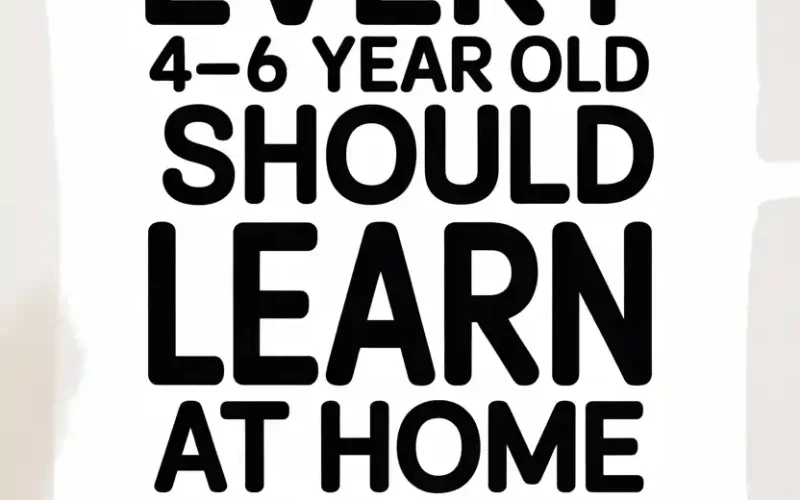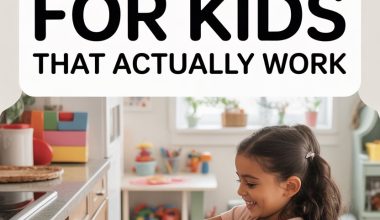Blink, and your child is building a pillow fort out of the good couch cushions (again). Age four through six is a blur of questions, giggles, and suspicious crayon stains.
But underneath all that energy, these early years are laying down foundations your child will use for a lifetime. No pressure, right?
The good news? Kids this age soak up learning from everyday life.
Home’s not just the place where socks go to disappear; it’s also where the most important lessons get their start.
Building Big Feelings into Big Skills
Emotional intelligence doesn’t just magically appear when someone hands out a school uniform.
Between 4 and 6, children become little emotional scientists—testing limits, pushing buttons, and occasionally staging dramatic fainting spells over the wrong kind of toast.
This is prime time for learning how to name feelings (“You look angry because your tower fell down”), manage disappointment, and handle that urge to throw the remote.
A great trick: narrate your own feelings and how you manage them. “Mum’s a bit grumpy that the cereal ran out, but she’s going to take a deep breath and choose toast.”
It’s not Shakespeare, but you’re modelling how to handle life’s little upsets.
Try games like “How do I feel?” where you both make faces and guess the emotion. Role-play sharing toys or waiting turns, using their toy dinosaurs or dolls as stand-ins. No lecture required.
Talking, Listening, and Chatterbox Training
Children learn new words faster than you can say “supercalifragilisticexpialidocious.” This is the age where language explodes. You want to feed that hunger for words—without feeling like you’re running a TED Talk every hour.
Read everything aloud: books, recipes, the back of the cereal box. Sing silly songs. Ask questions that need more than a yes or no answer (“Why do you think the cat is hiding?”).
Pause for your child’s reply. Even if their answer is “because she’s a secret unicorn,” you’re encouraging creativity and language at the same time.
If your family speaks more than one language, keep using both. Research shows bilingual children benefit socially and cognitively.
And when your child mispronounces a word (“pasketti” for spaghetti), repeat it correctly—no need to correct on the spot with a grammar pop quiz.
Numbers, Shapes, and That Magical World of Counting
No one expects you to become an amateur maths teacher overnight. The basics—counting, recognising shapes, and sorting—pop up all over the house.
Count stairs as you climb. Set the table together and count out forks. Point out rectangles, circles, and triangles lurking in your kitchen cupboards.
Have your child help sort socks or build a tower with blocks, noticing patterns and colours.
Board games like Snakes and Ladders sneak in number recognition and counting without anyone noticing the learning happening. (Bonus: it builds resilience when they land on a snake. Or outrage. Or both.)
Life Skills in Pyjamas
The best part? Many so-called “soft skills” don’t even need shoes. Independence grows when children are trusted with real, bite-sized jobs.
Pouring their own (small) glass of milk, tucking away their shoes, buttoning a shirt, or even asking for help—these are as important as anything they’ll learn from a worksheet.
Practice patience. Sometimes the milk lands on the floor. Well, that’s why there are paper towels.
Cooking together is gold. Cracking eggs, stirring, sprinkling cheese—these all boost fine motor skills and confidence. Plus, who can resist the allure of “secret ingredient spaghetti”?
Let them water plants, wipe spills, or help feed the cat (supervised, unless you want the cat to get a kilo of biscuits in one go).
Mastering chores feels like magic to a child. Grown-ups get a little help. Everyone wins.
The Art of Asking and Wondering
Around this age, children develop a dangerous superpower: why. Why is the sky blue? Why do we sleep? Why did that dog sniff my shoe?
Resist the urge to run for the hills. Curiosity is the engine of learning.
You don’t need all the answers—sometimes “Let’s find out together” is the perfect response. Google becomes your co-pilot, and you might learn something too.
Encourage experiments. “What happens if we stack all the boxes?” “Can you make it rain with a watering can?”
Simple science is everywhere. Mud pies count as chemistry. Mixing colours in the bath? Physics, surely.
Curiosity is contagious. If you show you’re interested, your child will be too—even if their questions get truly bizarre.
Friendship, Manners, and All the Social Stuff
Between four and six, friendships go from “You have a red jumper, I have a red jumper—let’s be best mates” to more complicated negotiations. Sharing, taking turns, and dealing with disappointment are huge skills.
Host playdates, yes, but also practice social skills with family: greeting guests, saying “please” and “thank you,” even if it comes out as a mumbled “fankoo.”
Children this age can help set the table, offer snacks, or help comfort a sibling who’s upset.
When conflict erupts (as it will), model how to solve problems calmly.
If someone grabs a toy or feelings are hurt, walk them through it: “Can you tell your friend how you feel? What could we do next time?” It’s not about perfection—it’s about practice.
Praising kindness when you spot it, even in small doses, builds positive social habits. “That was lovely how you gave your sister the last biscuit.” Just don’t expect sainthood.
They are still children, after all.
Creativity Isn’t Just for Rainy Days
Imagination is rocket fuel at this age. You don’t need an art degree or a craft cupboard worthy of Pinterest. Paper, crayons, a cardboard box, and some string can give you hours of creative play.
Let your child direct the fun. Maybe today the sofa cushions are pirate ships; tomorrow, the box is a robot.
Open-ended play helps children solve problems, negotiate roles (“You be the dragon, I’ll be the knight”) and express feelings in safe ways.
Music, dancing, and role-play all work wonders. If your little one wants to put on a “show” for an audience of one (that’s you), give them a standing ovation.
Creative confidence now leads to better problem-solving later.
Laying Strong Foundations for Reading
No prize for guessing this one: reading is the magic key. But don’t worry about flashcards or force-feeding phonics.
Your job at this stage? Make stories irresistible.
Read aloud every day, even if it’s just for five minutes. Let your child choose books. Follow the words with your finger, point out letters, have them guess what happens next.
If you get asked to read That One Book for the 800th time, take a deep breath—it’s helping more than you think.
Show that words matter outside books too: menus, signs, birthday cards. Scribble silly notes for them to “read.”
If you’re worried about learning differences, trust your instincts and reach out to your child’s teacher or your GP—early support is key and you’re not alone.
Physical Play and Body Confidence
Four-to-six-year-olds are bundles of movement—sometimes with the grace of a ballet dancer, sometimes more like a tipsy penguin. All this wriggling is their brain’s way of wiring itself for balance, coordination, and self-control.
Encourage jumping, running, skipping, and dancing. Try not to flinch when the living room becomes an obstacle course.
Playground visits, wrestling on the (safe) grass, or even simple yoga moves for kids build both gross and fine motor skills.
Fine motor skills get a boost from drawing, threading beads, or playing with playdough. These little muscles make writing, tying laces, and, crucially, opening snack packets much easier down the track.
Screen time? A little is fine—the American Academy of Pediatrics recommends balancing it with lots of active and imaginative play. No need for guilt trips or halo polishing.
Resilience and That Growth Mindset Hype
Children will get things wrong—a lot. Spilt milk, toppled towers, socks on backwards. That’s not just normal; it’s necessary.
Praise effort, not just success. “You worked really hard on that puzzle!” or “I love how you kept trying.” When things go pear-shaped, talk about what could be done differently next time.
Share your own mistakes (“Mum put salt in her tea instead of sugar—yuck!”) and show that messing up is a natural part of learning.
Carol Dweck’s growth mindset research shows that kids who believe they can improve through effort are more resilient and flexible thinkers. Perfection isn’t the goal. Curiosity and grit are.
It’s the Little Things That Count
Children absorb what’s around them: your patience on a difficult day, your laughter at a silly joke, your willingness to say “I don’t know, but let’s find out.”
Home is their first school, and you’re their favourite teacher—even if you don’t always feel up for the job.
Every story, every cuddle, every “help me tidy up” plants the seeds for lifelong learning.
And if you’re reading this while hiding in the loo just for five minutes of peace—you’re doing better than you think.





